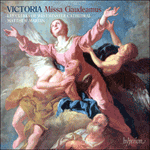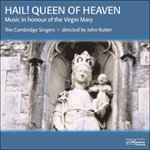
Welcome to Hyperion Records, an independent British classical label devoted to presenting high-quality recordings of music of all styles and from all periods from the twelfth century to the twenty-first.
Hyperion offers both CDs, and downloads in a number of formats. The site is also available in several languages.
Please use the dropdown buttons to set your preferred options, or use the checkbox to accept the defaults.

Victoria opens his motet with the three high voices followed by the three lower, and then he varies his vocal scoring with a wide variety of combinations mainly of three, four or six voices, often producing momentary double-choir effects. The frequent crossing of the tenor parts and especially of the two treble lines gives a bright shimmering quality to the music (Palestrina’s motet Assumpta est Maria has just the same vocal combination). Vidi speciosam appeared not only in the 1572 book but in 1576 (part 1 only), in 1583, 1585, 1589 (twice) and 1603. It was also copied into Cappella Sistina Codex 29.
from notes by Bruno Turner © 1984
Victoria inaugure son motet avec les trois voix aiguës, suivies des trois graves puis, diversifiant son écriture vocale, il recourt à un large éventail de combinaisons, pour la plupart à trois, quatre ou six voix et souvent à l’origine d’effets temporaires de double chœur. Le croisement fréquent des parties de ténor et, surtout, des deux lignes de soprano confère à la musique un éclatant chatoiement (le motet palestrinien Assumpta est Maria présente la même combinaison vocale). Vidi speciosam parut dans le recueil de 1572, mais aussi en 1576 (uniquement la partie I), en 1583, 1585, 1589 (deux fois) et 1603. Il fut également copié dans le Codex 29 de la Chapelle Sixtine.
extrait des notes rédigées par Bruno Turner © 1984
Français: Hypérion
Victoria beginnt seine Motette mit den drei hohen Stimmen, auf die die drei tieferen folgen, und dann variiert er seine Vokalbesetzung durch verschiedene Kombinationen, zumeist mit drei, vier oder sechs Stimmen, die oft für kurzzeitige Doppelchoreffekte sorgen. Das häufige Kreuzen der Tenorstimmen und besonders der beiden Sopranstimmen verleiht der Musik ein helles Schimmern (Palestrinas Motette Assumpta est Maria hat genau dieselbe Stimmkombination). Vidi speciosam erschien nicht nur in der Ausgabe von 1572, sondern auch in Ausgaben von 1576 (nur Teil 1), 1583, 1585, 1589 (zweimal) und 1603. Das Werk wurde ebenfalls im Codex 29 der Cappella Sistina verzeichnet.
aus dem Begleittext von Bruno Turner © 1984
Deutsch: Viola Scheffel
 Victoria: Missa Gaudeamus & other works Victoria: Missa Gaudeamus & other worksA new recording from Westminster Cathedral features the gentlemen of the choir in a fascinating programme which brings to life the musical and liturgical traditions of this foundation. This recording by the lay clerks of Westminster Cathedral pres ...» More |
 Hail! Queen of Heaven Hail! Queen of HeavenThis recording gathers together twenty-one examples of the extraordinary wealth of choral music inspired by the Virgin Mary, from Gregorian chant to the 20th-century sounds of Gustav Holst, Herbert Howells, Pierre Villette, Igor Stravinsky, Giles ...» More |
 Journeys to the New World Journeys to the New WorldAn album of gorgeous late-Renaissance polyphony from composers Cristóbal de Morales, Hernando Franco, Tomás Luis de Victoria, Francisco Guerrero, Alonso Lobo, Juan Gutiérrez de Padilla, Francisco López Capillas and Miguel Mateo de Dallo y Lana.» More |

